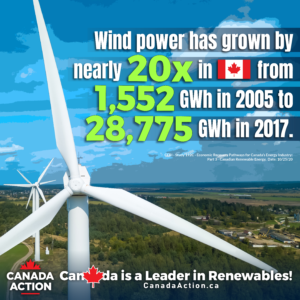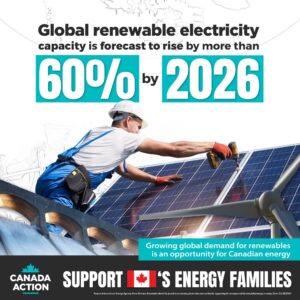Aiden Gonsalves – March 5, 2023
Explainer: Proposed Changes to Federal Clean Electricity Regulations
Electricity. The power outlet above my kitchen counter that my coffee machine is plugged into. Those green transformer boxes we used to hang out around as kids. Or, maybe, a big white wind turbine against the background of a picturesque meadow.
I don’t know about you, but that’s what I think of when I think “electricity.” But it’s so much more than that.
Canada’s electricity consumption in 2022 was 638.42 terawatt-hours (TWh), making it the world’s 4th largest per capita consumer of electricity. To put that into perspective, that’s the amount of electricity a toaster would use to toast 2 slices of bread (for 4 minutes) almost 8 trillion times. We’re going to need more peanut butter and jelly…
Joking aside, that’s a lot of electricity. More than 40 million Canadians rely on it every day. The proper functioning of electricity grids – the systems in which we generate electricity and deliver it to consumers – is crucial to Canada.
The Move to Decarbonize Canada’s Electricity Grids
Across Canada, there has been an effort to reduce the emissions produced as a by-product of generating electricity. This effort has been led jointly by both government (the federal government’s commitment to reaching net-zero by 2050, for example) and industry.

In the last couple of years, the federal government has begun to move towards a concerted regulatory approach to decarbonizing Canada’s electricity production. On August 10, 2023, the federal departments of Environment and Health jointly released the draft Clean Electricity Regulations (CER) – a vehicle to achieve a “net-zero electricity system.”
The August 2023 draft regulations were opened up for public consultation and received a mixed reception. The federal government claims that “most parties voiced support for the overarching goal of establishing a net-zero grid as a foundational element of achieving a net zero economy by 2050.” However, industry, power providers, and some provincial governments have opposed the CER, calling them impractical and uneconomical.
In an update to the public on February 16, 2024, the federal government released a “What We Heard” report that outlined some key changes to the CER it’s considering.
Let’s take a look at what the CER are, compare the original draft regulations to what’s now being suggested, and determine what’s at stake going forward.
The “What” and “Why” of the Clean Electricity Regulations
What?
The CER are – or will be – federal regulations that impose “performance standards” for electricity generation in order to reduce greenhouse gas (GHG) emissions. The regulations receive their delegated authority from the Canadian Environmental Protection Act (1999), drawing on constitutionally-granted health and environment powers.
The CER will apply to any “unit” that uses fossil fuels to generate electricity, has a capacity of 25 MW or more, and is connected to an electricity system that is subject to North American Electric Reliability Corporation standards. A “unit” is an electricity generating facility.
The “performance standards” the CER will impose are the most important component of the regulations. In the August 2023 draft regulations, the performance standard meant that units mustn’t emit more than 30 tonnes of carbon dioxide equivalent per gigawatt hour (CO2e/GWh) on average throughout a given year. This standard would begin applying to units in 2035, giving them time to develop and install carbon capture and storage (CCS) technologies that would reduce emissions to the required level.
However, due to backlash and opposition following the publication of the draft regulations in August 2023, the February 2024 “considered” regulations modify the performance standard component.
Rather than imposing a cap on the emissions intensity of each unit (30 CO2e/GWh), the proposed change to the CER “suggests the material change of limiting post-2035 natural gas generation emissions intensity to a best available technology standard.” The proposed replacement for the performance standard is what the federal government calls a “unit-specific annual emissions limit.” In essence, the new approach would, rather than setting a blanket emissions intensity cap, instead set a limit tailored to each unit’s capacity.
Another key change to the CER being considered is adding a pooling component. Pooling would allow entities who own multiple units to have a single limit for the combined emissions of all their units. This would allow more efficient units to compensate for less efficient units, giving electricity providers more flexibility in how they implement CCS technology and other emissions-reducing strategies.
There’s plenty more to the CER – both with the August 2023 draft regulations and the updated February 2024 version. Scroll to the comparison table below for more, or check out the breakdowns from the Canadian Climate Institute, Norton Rose Fulbright, or Osler.
Why?
The CER are a part of the federal government’s mission achieve a net-zero electricity system, which, in turn, will help move Canada towards total net-zero emissions by 2050. They are part of a suite of environment-focussed federal measures introduced in recent years to combat the ever-increasing risks posed by climate change. The proposed emissions cap framework for the oil and gas sector, carbon pricing, and the Impact Assessment Act are a few other examples of the same ilk.
To better understand why the CER are being introduced (and why they will have a profound impact on some electricity grids more than others), it’s important to have a baseline understanding of how electricity is produced in Canada.
The main electricity sources in Canada are hydroelectricity, nuclear power, natural gas, and coal (with renewable sources like wind and solar making up the remainder). Manitoba, Newfoundland and Labrador, Quebec, and British Columbia get their electricity mostly from hydroelectricity. Ontario uses a lot of nuclear power, as well as other sources to power its 15+ million people. Like Ontario, New Brunswick also has a diversified grid, with almost 40% coming from nuclear. Prince Edward Island (PEI) uses 99% wind power.
Territories aside (they’re a different story for another article), that leaves Alberta, Saskatchewan, and Nova Scotia. Around 60% of Alberta’s electricity comes from natural gas. Saskatchewan and Nova Scotia’s electricity comes mostly from natural gas and coal.
Though the CER will apply at the federal level (to all provinces), the regulations target fossil fuel power facilities. As you can see, that means provinces like Ontario, Quebec, and BC are largely unaffected by the CER because they don’t source their electricity from non-renewable sources. Alberta, Saskatchewan, and Nova Scotia, on the other hand, will bear the full brunt of the regulations.
This effect has been stressed by many opponents to the CER, including provincial governments, power producers, and experts. Opponents argued that the original draft CER weren’t financially feasible and were out of touch with how “ready” Canada is to shift away from high-emission electricity generation. The governments of Alberta and Saskatchewan even went as far as releasing statements indicating they would block the CER from being implemented in their respective provinces.
The federal government, in hearing extensive feedback on the draft CER, has attempted to improve the regulations in respect of how “realistic” they are. Moving from the performance standard model to the “unit-specific annual emissions limit” (mentioned above) is one example.
Another modification to the newly proposed CER responds to concerns that the unreliability of renewable energy would render prairie electricity grids unstable. Alberta Premier Danielle Smith warns about “blackouts” the province may suffer if the shift to renewable power generation happens at the rate the federal government wants it to. The general idea behind this rationale is that because wind power relies on wind and solar power relies on the sun, changing weather patterns and winter storms will make renewable electricity unreliable.
The February 2024 CER update provides some changes to the protocol for emergency situations (outlined below), but Alberta’s Minister of Environment and Protected Areas, Rebecca Schulz, still disapproves and has expressed that the changes don’t go far enough.
To sum it up, the CER have been a hot-button issue for the provinces the regulations would affect most. Though the updated regulations make meaningful changes that’re informed by the substantial feedback collected in the last few months, it’s unclear whether the final regulations will “work” for those impacted by them. Adding the fact that it’s also unclear what the final regulations will look like, the CER will definitely be an issue to watch in 2024.
Comparing New vs. Old
Here’s a comparison chart that highlights a few key changes to the CER that’re currently under consideration, as per the February 2024 release:
Original Draft CER (August 2023) |
“Changes Being Considered” for CER (February 2024) |
|
Performance Standards |
30 t/GWh, equivalent to 95% capture rate. | “Unit-specific annual emissions limit”. |
Pooling |
None. | Parties owning multiple units can be prescribed a combined emissions limit for all their units (allowing for more flexibility). |
Emergencies |
“System operator declares emergency. Federal Minister must approve retroactively for emissions to be exempted.” | “Allowing a provincial system operator, rather than just the federal minister, to declare an emergency and suspend the emissions limits for a “reasonable period of time,” provided the federal minister is notified.”
Responds to concerns about emergencies (weather events, “blackouts,” etc.) by adapting rules for exemptions. |
Unit Classifications |
“Units commissioned by Dec 31, 2024 are existing units and exempt until end of prescribed life” (20 years). | “Units with substantial investment and work underway before January 1, 2025 and that start selling electricity to the grid by [TBD] would also receive an end of prescribed life”.
Expands allowances for electricity generating facilities (“units”), allowing for more flexibility. |
Sources: Canadian Climate Institute, Norton Rose Fulbright, Osler
What’s Next?
Environment and Climate Change Canada (ECCC) – the federal department behind the CER – continues to invite feedback to the CER until March 15, 2024. It intends to seek approval and publish the final CER sometime in 2024. According to a CBC report, this timeline is subject to “wiggle room.”
It’s unclear what will happen with the CER on a political level, especially considering some provinces’ strong opposition to the regulations, even with the proposed changes. Further, the February 2024 public update didn’t provide certainty as to what changes will actually be implemented. This leaves uncertainty for a multi-billion-dollar Canadian power sector.
If you’d like to learn more about the CER and what’s in store for electricity generation in Canada, keep an eye on the news and ensure you’re subscribed to YCR’s newsletter.
